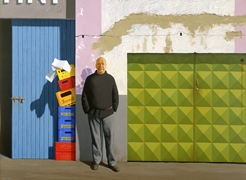21 June 2013
 The University of South Australia will honour the life and contribution of the great Australian artist Jeffrey Smart by naming its major new $90m learning centre building, the Jeffrey Smart Building.
The University of South Australia will honour the life and contribution of the great Australian artist Jeffrey Smart by naming its major new $90m learning centre building, the Jeffrey Smart Building.
The decision to honour the artist was made by the University Council yesterday, only hours before learning of Smart’s death in Tuscany overnight, although the artist’s permission to use his name in this way had been obtained some weeks ago.
University Vice Chancellor Professor David Lloyd said the contribution Smart has made to Australian art has been significant and enduring.
“We were privileged to hold a unique retrospective of Jeffrey Smart’s lifetime’s work last year in our Samstag Museum - Master of Stillness: Jeffrey Smart paintings 1940 -2011 - which was a very special event and one that showcased the great talents of this artist,” Prof Lloyd said, “and were delighted that he accepted the award of an Honorary Doctorate from the University in 2011”.
“His highly individual style, his commitment to his work and his lifelong passion for always learning and innovating in his craft were evident in every piece. It is that spirit we will honour in the naming of our learning centre, located at the heart of the city where Jeffrey Smart first explored his talent.”
Born in Adelaide in 1921 Smart had an early passion for drawing but initially aspired to become an architect.
Instead he studied teaching at the Adelaide Teachers’ College and the SA School of Arts and Crafts, two antecedents of the University of South Australia and then worked for five years as an art teacher for the South Australian Education Department in the 1940s before travelling to Europe.
Following his passion, he studied further in Paris at La Grand Chaumiėre and later at the Acadėmie Montmartre.
By 1950 he was living on the island of Ischia in the Bay of Naples with Australian compatriots Donald Friend, Michael Shannon and Jacqueline Hick before returning to Sydney in 1951 where he worked for the next 12 years as a teacher, art critic and children’s radio and television presenter.
He continued to paint and exhibit throughout this period and then returned to Italy where he settled permanently in the heart of Tuscany.
It was in Adelaide that he sold his first painting. Smart recalled it was in 1943 that fellow artist Max Ragless bought the work, a landscape of the city for three guineas at a joint exhibition with Jacqueline Hick at the Royal South Australian Society of Arts.
Just a year later the Art Gallery of South Australia bought Water towers – still a proud part of its South Australian collection.
Undeniably one of Australia’s most famous and talented artists, Jeffrey Smart has been characterized as a surrealist, an off-beat classicist and a metaphysical painter, but ultimately he defies classification.
Reflecting on his career Smart noted his early education in Adelaide was vital.
“At art school I was taught tonal painting by Ivor Hele and Marie Tuck, after which it was Dorrit Black who opened my eyes to the dynamic symmetry of ‘the moderns’. She taught us about the Golden Mean and how it applied to abstract and cubist painting. All that prepared me for lessons I later received in Paris from Fernand Léger. These foundations were so important,” he said.
The influence of Adelaide and South Australia went beyond art school, its community of artists and encouraging early patronage.
“It would be fair to say that the unique shape and light of these South Australian landscapes, together with my fascination for city motifs, formed the alpha and omega of the way I would continue to see the world through my painting,” Smart said.
Curator of the Jeffrey Smart retrospective exhibition and distinguished South Australian School of Art alumnus Barry Pearce, who recently retired after 30 years as Head Curator of Australian Art at the Art Gallery of New South Wales, said Smart’s legacy would be enduring.
“When as a young man Jeffrey Smart decided he would eventually live permanently in Italy, it was his dream to be near the essence of European culture which he most valued as a man and artist,” Pearce said.
“That he carried this out without severing connections to the country of his birth, he in effect created a bridge across two hemispheres for the rest of us, whatever our backgrounds and diversity of birthright.
“And he gave us an even more important legacy: through his urban imagery, a way of engaging the technological world that we have created and, however plebeian, or brutal, or disturbing it may seem, of taking command of it through the imagination with a strange new sense of beauty; of an essential stillness somewhere against the force of relentless time and change.”
Media contact: Michèle Nardelli office: 08 8302 0966 mobile: 0418 823 673 email: Michele.nardelli@unisa.edu.au





